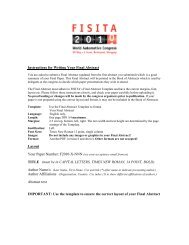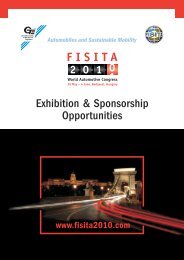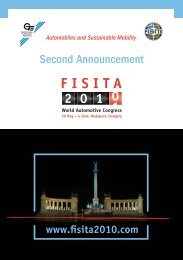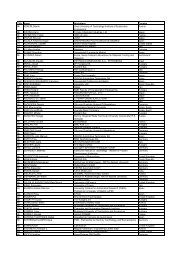A Study on the Joint Structures for the Improvement of Stiffness and ...
A Study on the Joint Structures for the Improvement of Stiffness and ...
A Study on the Joint Structures for the Improvement of Stiffness and ...
You also want an ePaper? Increase the reach of your titles
YUMPU automatically turns print PDFs into web optimized ePapers that Google loves.
Sessi<strong>on</strong>: B2A <str<strong>on</strong>g>Study</str<strong>on</strong>g> <strong>on</strong> <strong>the</strong> <strong>Joint</strong> <strong>Structures</strong> <strong>for</strong> <strong>the</strong> <strong>Improvement</strong> <strong>of</strong> <strong>Stiffness</strong> <strong>and</strong>CrashworthinessPark, Chang-Wook * An, Y<strong>on</strong>gdok Kim, Dae SeungHyundai∙Kia Motors, 772-1, Jangduk-D<strong>on</strong>g, Hwase<strong>on</strong>g-Si, Gye<strong>on</strong>ggi-Do, 445-706, KoreaKey Word: Body-in-White, BIW, Load-Path Analysis, <strong>Joint</strong> <strong>Stiffness</strong>, CrashworthinessABSTRACT<strong>Joint</strong> structures in BIW play a significant role in <strong>the</strong> NVH <strong>and</strong> crashworthiness <strong>of</strong> vehicle. Theresearches <strong>on</strong> <strong>the</strong> design <strong>of</strong> joint structures, however, are very limited. The main drawbacks in <strong>the</strong>design <strong>of</strong> joint structures are complexity <strong>and</strong> difficulty in assessment <strong>of</strong> effectiveness to globalper<strong>for</strong>mance. For example, B-pillar lower joint c<strong>on</strong>nects rocker with B-pillar. This joint partgenerally effects to <strong>the</strong> torsi<strong>on</strong>al stiffness <strong>of</strong> BIW <strong>and</strong> also c<strong>on</strong>tributes in side impact situati<strong>on</strong>.However, it is very difficult to decide a certain joint structure is well-designed or has enoughrigidity. Load-path analysis can be a good alternative to this problem. The characteristics, functi<strong>on</strong>s<strong>and</strong> <strong>the</strong> robustness <strong>of</strong> each joint structure are identified by employing load-path analysis. Using thishelpful methodology, we suggest new BIW design with improved joint structures. We first selected9 joint structures in BIW (Fig. 1) to be modified as following;1) Fr<strong>on</strong>t apr<strong>on</strong> ~ A-pillar: load-path improvement,2) Cowl ~ Strut tower ~ A-pillar: increasing secti<strong>on</strong> <strong>and</strong> c<strong>on</strong>nectivity improvement,3) A-pillar ~ Rocker ~ Rear wheel house: increasing joint stiffness,4) Rear floor cross member: increasing secti<strong>on</strong>,5) ~8) Rear structures: supplement <strong>of</strong> c<strong>on</strong>nectivity <strong>for</strong> disc<strong>on</strong>tinuous parts,9) Package tray: increasing secti<strong>on</strong> <strong>for</strong> ring structures <strong>and</strong> additi<strong>on</strong>al load-path.Fig. 1 Improved joint structures*Corresp<strong>on</strong>ding author. Tel.: +82-31-368-3349; fax: +82-31-368-3327,E-mail : cwpark66@hyundai.com
Fig. 2 Changes in rear structuresFor example, analysis results showed that load-path is not c<strong>on</strong>tinuous in rear structures (5~8). Newparts are added to c<strong>on</strong>nect above disc<strong>on</strong>tinuous structures. (Fig. 2) These modificati<strong>on</strong>s complete<strong>the</strong> ring structure in rear body <strong>and</strong> also provide new load-paths. Mainly above problems are causedby manufacturing reas<strong>on</strong>s; limited approaching range <strong>of</strong> resistance spot welding <strong>and</strong>/or cycle timec<strong>on</strong>straint <strong>of</strong> arc welding. Laser welding is applied to overcome <strong>the</strong>se issues. Per<strong>for</strong>mance <strong>of</strong> newBIW is increased 83 % in static rigidity <strong>and</strong> 13 % in dynamic aspect. For crashworthiness, intrusi<strong>on</strong>into compartment in IIHS OFFSET test is decreased by 14 %. Total mass increase is 4.3 kg, but<strong>the</strong>re was no major change in previous parts. This means that our future works is to optimize bothnew <strong>and</strong> previous part.









